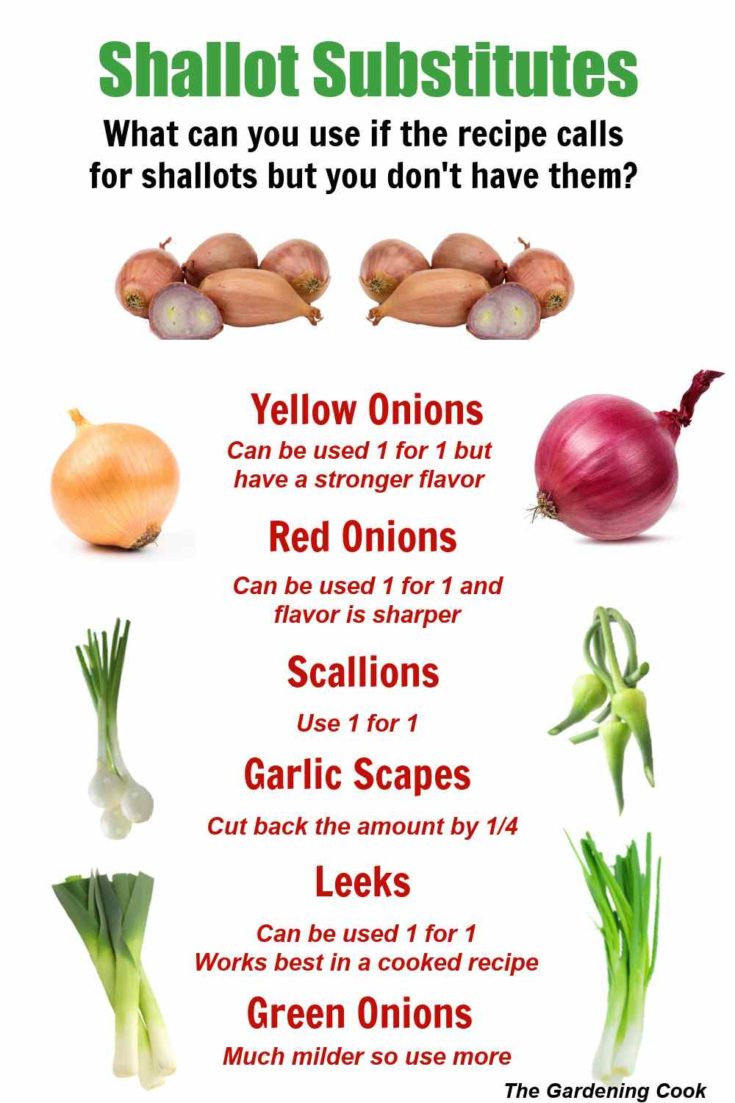Onions and garlic, a dynamic duo in the world of culinary wonders.
These versatile ingredients bring depth and flavor to countless dishes, but what do you do when you find yourself desperately searching for a substitute for shallots?
Fear not!
In this article, we’ll explore the bountiful alternatives that onions and garlic offer in their various forms, ensuring that your kitchen creations never lack that distinctive, savory touch.
Get ready to embark on a tantalizing journey of culinary discovery!
substitute for shallots
A suitable substitute for shallots is yellow onions.
Additionally, chives, garlic, scallions, red onions, leeks, pearl onions, garlic scapes, dried onions, and garlic powder can be used as alternatives to shallots.
Key Points:
- Yellow onions can be used as a substitute for shallots.
- Chives, garlic, scallions, red onions, leeks, pearl onions, garlic scapes, dried onions, and garlic powder are also applicable alternatives to shallots.
substitute for shallots – Watch Video
💡
Pro Tips:
1. Did you know that the substitute for shallots in cooking can be green onions? Green onions, also known as scallions, can provide a similar flavor profile to shallots, especially when cooked.
2. In case you can’t find shallots, another alternative is to use red onions as a substitute. While the taste may be slightly different, red onions can add a similar sweet and pungent flavor to your dishes.
3. Leeks can also be used as a substitute for shallots, particularly if you prefer a milder taste. Just keep in mind that leeks might have a slightly different texture, so be sure to adjust your cooking method accordingly.
4. If you’re looking for a more unconventional alternative, try using dried minced onion as a substitute for shallots. While it won’t provide the same texture as fresh shallots, it can still infuse your dishes with a subtle onion flavor.
5. In a pinch, you can even use garlic as a substitute for shallots. Keep in mind that garlic has a stronger and more distinct flavor, so you might want to use it sparingly to avoid overpowering the other ingredients in your dish.
1. Yellow Onions
Yellow onions are a versatile substitute for shallots in many recipes. They have a milder flavor compared to shallots but can be cooked to develop a sweeter taste. Yellow onions have a classic onion flavor with a slight tang, making them suitable for dishes like stir-fries, soups, and stews.
When using yellow onions as a substitute, keep in mind that they may have a firmer texture than shallots. To achieve a similar consistency, dice the yellow onions finely to mimic the shallot’s smaller size. Additionally, if you prefer a more delicate flavor, you can soak the diced yellow onions in cold water for 10-15 minutes to reduce their pungency.
In terms of quantity, you can use approximately 1/2 cup of yellow onions to substitute for every 1/2 cup of shallots in a recipe. Adjust the amount according to your personal taste preferences and the intensity of the dish you are preparing.
2. Chives
Chives, with their mild onion-like flavor, are a great option when you want a milder taste compared to shallots. These slender green herbs are part of the same family as onions and garlic, offering a flavorful alternative.
To substitute shallots with chives, finely chop them to match the texture of shallots. While chives are commonly used as a garnish due to their delicate nature, they can also impart a subtle onion flavor to dishes like salads, mashed potatoes, and omelets.
When substituting shallots with chives, it’s crucial to use larger quantities to achieve a similar flavor. As a general rule, use three times the amount of chopped chives that the recipe specifies for shallots. For instance, if a recipe calls for 1 tablespoon of shallots, use 3 tablespoons of chopped chives.
3. Garlic
While garlic has a different taste compared to shallots, it can be a suitable substitute in dishes where its distinct flavor profile complements the other ingredients. Garlic has a bold, aromatic taste that adds complexity to a variety of preparations, including pasta sauces, roasted vegetables, or marinades.
When substituting shallots with garlic, it’s crucial to adjust the quantity according to your preferences. If the recipe originally called for raw shallots, mince or finely chop the garlic before using. In cooked dishes, garlic cloves can be used whole, crushed, or minced, depending on the desired intensity and texture.
Keep in mind that garlic can be overpowering if not used with restraint. Start with small quantities, taste as you go, and add more if necessary.
Substitution ratio:
- For every 1 tablespoon of shallots, you can use 2-3 large garlic cloves as a substitute.
4. Scallions
Also known as green onions, scallions can be a suitable substitute for shallots, especially when their mild and slightly sweet flavor is desired. Scallions have a fresh, crisp texture and a subtly onion-like taste that can enhance salads, soups, stir-fries, and other dishes.
To use scallions as a substitute for shallots, slice both the white and green parts of the scallions finely. The white part has a stronger flavor reminiscent of shallots, while the green part adds a hint of freshness.
When substituting shallots with scallions, you typically need to use a larger quantity due to the milder flavor profile. Use approximately twice the amount of sliced scallions compared to the amount of shallots stated in the recipe.
- Scallions are a suitable substitute for shallots, especially when their mild and slightly sweet flavor is desired.
- Scallions have a fresh, crisp texture and a subtly onion-like taste.
- Slice both the white and green parts of the scallions finely.
- The white part of scallions has a stronger flavor similar to shallots.
- The green part of scallions adds a hint of freshness.
- Use approximately twice the amount of sliced scallions compared to the amount of shallots stated in the recipe.
5. Red Onions
Red onions can be a great substitute for shallots when you want to incorporate their unique sweetness into a dish. Compared to yellow onions, red onions have a milder taste and can bring a mild tanginess to recipes that require shallots.
When substituting shallots with red onions, it is important to finely chop or dice them to ensure that the flavor distributes evenly throughout the dish. You can use red onions in raw preparations such as salads or salsas, where their vibrant color not only adds visual appeal but also enhances the flavor. Additionally, you can sauté or caramelize red onions to unlock their natural sweetness and replicate the depth of flavor that shallots provide.
When substituting shallots with red onions, use approximately the same amount as indicated in the recipe. However, keep in mind that red onions may have a slightly stronger taste, so you might want to adjust the quantity based on your preference.
6. Leeks
Leeks can be an excellent substitute for shallots in various dishes due to their mild onion-like flavor. They belong to the same family as shallots and scallions, which gives them a similar taste profile.
To use leeks as a substitute, focus on the white and light green parts as they provide the strongest flavor. Make sure to clean the leeks thoroughly to remove any dirt, then finely chop or slice them before adding to your dish.
Leeks work particularly well in soups, stews, and slow-cooked dishes where their delicate taste can infuse the dish with a mild onion flavor. They can be sautéed, braised, or added to stocks, offering depth and complexity to the overall taste.
As a general guideline, you can substitute chopped leeks in the same amount as shallots in a recipe. However, it is recommended to taste the dish as you go and adjust the quantity according to personal preferences and the desired intensity of the dish.
- Select the white and light green parts of leeks for stronger flavor.
- Clean leeks thoroughly before using.
- Finely chop or slice leeks.
- Use in soups, stews, and slow-cooked dishes.
- Sauté, braise, or add to stocks for added depth.
- Substitute equal amounts of leeks for shallots in a recipe.
- Adjust quantity based on personal preferences and dish intensity.
7. Pearl Onions
Pearl onions can be an interesting substitute for shallots in recipes where their delicate taste is desired. They are tender, mild, and slightly sweeter than shallots, making them a delightful addition to various preparations.
When using pearl onions as a substitute, you can either keep them whole or slice them in half, depending on your preference and the recipe requirements. They can be lightly sautéed, roasted, pickled, or added to stews and braises, providing a unique flavor dimension to the dish.
- Keep pearl onions whole or slice them in half
- Lightly sauté, roast, or pickle pearl onions
- Add them to stews and braises for a unique flavor
- Adjust the quantity of pearl onions to achieve desired flavor impact
Note: Due to their smaller size, you may need a larger quantity of pearl onions compared to shallots to achieve a similar flavor impact. Adjust the amount based on your taste preferences and the desired intensity of the final dish.
8. Garlic Scapes
Garlic scapes are the curly green shoots that emerge from garlic bulbs. They have a mild garlic flavor with a hint of sweetness, making them an interesting substitute for shallots when their unique taste is desired.
When using garlic scapes as a substitute, finely chop or slice them before incorporating them into your dish. They can be sautéed, stir-fried, or used in pestos and sauces to provide a fresh and vibrant garlic taste.
- Key points:
- Garlic scapes are curly green shoots that emerge from garlic bulbs.
- They have a mild garlic flavor with a hint of sweetness.
- They can be used as a substitute for shallots when their unique taste is desired.
- Finely chop or slice garlic scapes before incorporating them into your dish.
- They can be sautéed, stir-fried, or used in pestos and sauces.
- Adjust the quantity of garlic scapes based on personal taste preferences and the desired flavor profile of the recipe.
“Garlic scapes are a versatile ingredient that adds a fresh and vibrant garlic taste to your recipes. They can be used in various dishes, including sautés, stir-fries, pestos, and sauces. Don’t be afraid to experiment with the quantity to achieve the desired flavor intensity.”
9. Dried Onions
Dried onions, available as flakes or powder, make a convenient substitute for shallots. While the texture may be different from fresh shallots, dried onions retain a powerful onion flavor that can enhance a variety of dishes.
To substitute shallots with dried onions, rehydrate them in warm water for a few minutes until they soften and regain some moisture. Then, drain off any excess water before adding them to your recipe.
Bullet Points:
- Rehydrate dried onions in warm water before using as a substitute for shallots
- Drain off excess water before adding to the recipe
- Dried onions are great for spice blends, meat rubs, and dry marinades
- They can also enhance soups, stews, and marinades
- Use approximately 1 tablespoon of dried onions for every 1/2 cup of chopped shallots in a recipe
10. Garlic Powder
Garlic powder is a convenient alternative substitute for shallots when a rich garlic flavor is desired. Derived from dehydrated garlic cloves and ground into a fine powder, it can add an intense garlic taste to a wide array of recipes.
When using garlic powder as a substitute, start with a small amount and gradually add more according to your taste preferences and recipe requirements. Remember that garlic powder is more potent than fresh garlic, so a little goes a long way.
To incorporate garlic powder into your dishes, use it in spice blends, marinades, salad dressings, or seasoning mixes to provide a concentrated garlic taste. When substituting shallots with garlic powder, use approximately 1/2 teaspoon of powder to replace every tablespoon of chopped shallots. Adjust the quantity based on your preference for garlic flavor.
There are various tasty substitutes for shallots, each offering a unique flavor profile and application. From yellow onions to garlic powder, chives to leeks, you have a range of options to choose from depending on your preferences and the dish you are preparing. Explore different substitutes to discover new flavors and create delicious dishes, even if you don’t have shallots on hand.
💡
You may need to know these questions about substitute for shallots
What kind of onion can replace shallots?
Red onions can be a suitable replacement for shallots. While they have a slightly stronger flavor, red onions provide a similar depth and complexity that shallots are known for. They also add a pop of color to your dishes, making them a versatile substitute for shallots in various culinary preparations.
How much of an onion is equivalent to a shallot?
Shallots and onions offer distinct flavors, making it important to consider equivalencies when substituting one for the other. In terms of volume, roughly speaking, a shallot can be equivalent to a small yellow onion. However, it is important to note that while shallots bring a delicate sweetness with a hint of sharpness, onions bring a more robust and intense heat. Therefore, when substituting shallots for onions in a recipe, maintaining the same volume is essential for maintaining the overall balance of flavors.
Why do chefs use shallots instead of onions?
Chefs often opt for shallots instead of onions due to their unique flavor profile. Shallots possess a mild pungency and a delicate sweetness that blends harmoniously in a variety of dishes. This balanced taste is particularly valuable when preparing meals where onions might dominate and overshadow the other flavors. Additionally, shallots are versatile as they retain their richness even when cooked, making them equally enjoyable in both warm and cold dishes.
Are red onions and shallots interchangeable?
While red onions and shallots can be used interchangeably in cooked dishes, their flavor profiles differ. Shallots possess a milder taste, which makes them preferable in raw preparations like sliced on a salad or minced in dressings. This distinction should be taken into account when substituting one for the other in recipes.
Reference source
https://www.thekitchn.com/shallot-substitutes-23517794
https://www.healthline.com/nutrition/shallot-substitute
https://www.acouplecooks.com/best-shallot-substitute/
https://www.bonappetit.com/story/all-about-shallots


